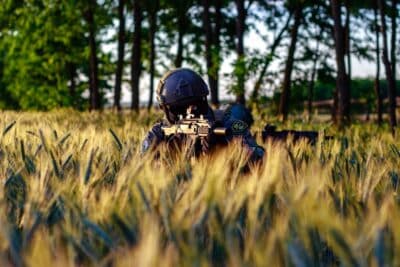Homeland security agencies are vital to the safety of countries in a world that is constantly changing and full of threats and unknowns. A big part of their job is to be ready for emergencies and act quickly when they happen.
Tactical gear, which is a wide range of tools made to help in dangerous situations, is an essential part of their arsenal. In this article, we look at how important tactical gear is to homeland security organizations’ preparedness and response efforts.

IMAGE: PEXELS
1. Introduction
Homeland Security And Its Responsibilities
Before we dive into the world of tactical gear, it’s essential to understand the nature of homeland security. Homeland security encompasses various agencies and organizations tasked with protecting the homeland from a multitude of threats, both natural and man-made.
These agencies include the Federal Emergency Management Agency (FEMA) and the Department of Homeland Security (DHS). Their responsibilities range from disaster management and emergency response to counterterrorism efforts.
Significance Of Tactical Gear
Tactical gear is a category of equipment designed for specific tactical and operational purposes. These include firearms, body armor, communication devices, personal protective equipment, tools, and more. The significance of tactical gear lies in its ability to enhance the capabilities of homeland security personnel, ensuring their safety and efficiency during critical missions.
2. Tactical Gear In Homeland Security
How To Understand Tactical Equipment
Tactical gear is more than just gear; it’s a lifeline for people who are on the front lines of security and crisis management. Its purpose goes beyond what is clear. It needs to be strong, portable, flexible, and protective. These traits are essential because the places where homeland security agencies work are often difficult and hard to predict.
3. Tactical Gear Components
1. Guns And Rounds Of Ammunition
No one makes fun of the fact that homeland security services use guns. Each type of gun and round of ammo is used for something different. People need a lot of training for these tools to be used safely and effectively. If you know how to use it well, the right gun can make you stronger.
2. Body Armor And Ballistic Protection
Body armor, with varying levels of protection (Check: https://pspcorp.ca/phalanx-hsv-vest), is vital for the safety of personnel. These protective layers are designed to withstand ballistic threats, providing peace of mind for those in harm’s way.
3. Communication And Surveillance Equipment
Effective communication and real-time information sharing are essential during crisis response. Radios, surveillance cameras, and drones provide vital situational awareness, aiding decision-making and coordination.
4. Personal Protective Equipment (PPE)
Helmets, gloves, and gas masks are part of the personal protective equipment designed to keep personnel safe from a range of hazards, including chemical and biological threats.
5. Tools And Accessories
Tactical knives, tactical pen, flashlights, medical kits, and breaching tools are essential components for a versatile response toolkit. These tools can be lifesavers in certain situations.
4. Tactical Gear In Preparedness
The Role Of Training And Skill Development
Homeland security agencies invest heavily in training their personnel. Firearm training and tactical drills are critical to ensure that operators are proficient with their gear and can respond effectively in high-stress situations.
Stockpiling And Maintenance
Maintaining an inventory of tactical gear is crucial for readiness. Regular maintenance ensures that gear is in optimal condition when it’s needed most.
Integration With Emergency Plans
Tactical gear plays a significant role in emergency protocols and disaster management plans. It’s an integral part of the strategy to mitigate, respond to, and recover from crises.
5. Tactical Gear In Crisis Response
Rapid Deployment And Mobility
Tactical gear enables quick-response teams to deploy rapidly and effectively. The mobility afforded by this equipment can be the difference between success and failure in a crisis.
Protection And Safety
The safety of personnel and civilians is paramount. Tactical gear provides essential protection, allowing operators to confidently enter dangerous situations.
Communication And Coordination
Interagency communication is crucial during large-scale crises. Tactical gear with advanced communication capabilities fosters seamless coordination among agencies, improving overall response efficiency.
6. Challenges And Considerations
Budget Constraints
Homeland security agencies must navigate budget limitations while ensuring that their tactical gear remains effective and up to date.
Balancing Lethal And Non-Lethal Gear
The careful selection of gear, including non-lethal options, helps agencies maintain a measured approach in their response efforts.
Public Perception And Accountability
Homeland security agencies must maintain transparency and accountability in their use of tactical gear to foster trust within the community.
7. Future Trends And Innovations
Technological Advancements In Tactical Gear
The integration of advanced technology, including AI and robotics, is on the horizon. These innovations promise enhanced capabilities for homeland security agencies.
Sustainability In Tactical Gear Manufacturing
Sustainable practices in gear manufacturing not only reduce environmental impact but also contribute to long-term cost savings.
8. Conclusion
When it comes to home protection, you can’t say enough about how crucial tactical gear is. It gives agencies the tools they need to do their jobs of being ready and responding quickly.
As technology changes and new problems arise, the role of tactical gear in national security will continue to change, making sure that countries are safe and secure in times of disaster and crisis.

IMAGE: PEXELS
If you are interested in even more technology-related articles and information from us here at Bit Rebels, then we have a lot to choose from.
COMMENTS